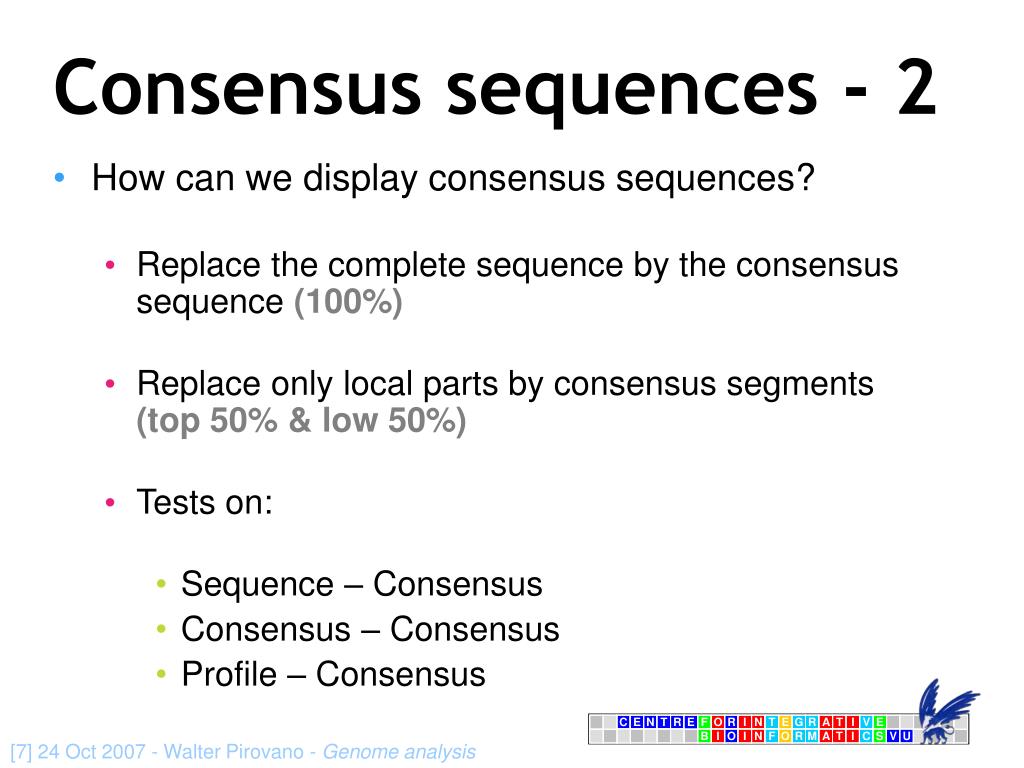
Sequence logos from biological sequence alignments as easy and painless as possible.īuilding on the WebLogo 3 source code, LogOddsLogo uses per-observation multiple-alignment log-odds scores as measures of informationĬontent at each position of a sequence logo. Is a web based application designed to make the generation of Creating Sequences Logos using the Web interface.Recommendations for Making Sequence Logos.GitHub Sequence Logo in native Javascript.
#Are sequence logos better than consensus sequences Offline#
Make a Sequence Logo in your browser, offline."Skylign: a tool for creating informative, interactive logos representing sequence alignments and profile hidden Markov models". ↑ Wheeler, Travis J Clements, Jody Finn, Robert D (13 January 2014)."BioWord: a sequence manipulation suite for Microsoft Word". ↑ Anzaldi LJ Muñoz-Fernández D Erill I."Information content of binding sites on nucleotide sequences". "Sequence Logos: A New Way to Display Consensus Sequences". In an HMM sequence logo used by Pfam, three rows are added to indicate the frequencies of occupancy (presence) and insertion, as well as the expected insertion length. Hidden Markov models (HMMs) not only consider the information content of aligned positions in an alignment, but also of insertions and deletions. Consensus logos represent therefore an improvement over consensus sequences whenever motif/alignment information has to be constrained to text. That being said, the need to include graphic figures in order to display sequence logos has perpetuated the use of consensus sequences in scientific manuscripts, even though they fail to convey information on both conservation and frequency. Hence, a sequence logo should be used preferentially whenever possible. As a result, compared to a sequence logo, the consensus logo omits information (the relative contribution of each character to the conservation of that position in the motif/alignment). As described above, the consensus logo is a cross between sequence logos and consensus sequences. The main, and obvious, advantage of consensus logos over sequence logos is their ability to be embedded as text in any Rich Text Format supporting editor/viewer and, therefore, in scientific manuscripts. Instead of a stack made of several characters, denoting the relative frequency of each character, the consensus logo depicts the degree of conservation of each position using the height of the consensus character at that position.Ī consensus logo for the LexA-binding motif of several Gram-positive species. However, a consensus logo displays only conservation information, and not explicitly the frequency information of each nucleotide or amino acid at each position. Like a sequence logo, a consensus logo is created from a collection of aligned protein or DNA/RNA sequences and conveys information about the conservation of each position of a sequence motif or sequence alignment The information content (y-axis) of position \displaystyle is the number of sequences in the alignment.Ī consensus logo is a simplified variation of a sequence logo that can be embedded in text format.

Sequence logos can be used to represent conserved DNA binding sites, where transcription factors bind. The height of the entire stack of residues is the information measured in bits. Different residues at the same position are scaled according to their frequency. The sequence logo will show how well residues are conserved at each position: the higher the number of residues, the higher the letters will be, because the better the conservation is at that position. A sequence logo can then be created from the conserved multiple sequence alignment. To create sequence logos, related DNA, RNA or protein sequences, or DNA sequences that have common conserved binding sites, are aligned so that the most conserved parts create good alignments. The total height of the letters depicts the information content of the position, in bits.

The relative sizes of the letters indicate their frequency in the sequences. A sequence logo consists of a stack of letters at each position.


 0 kommentar(er)
0 kommentar(er)
